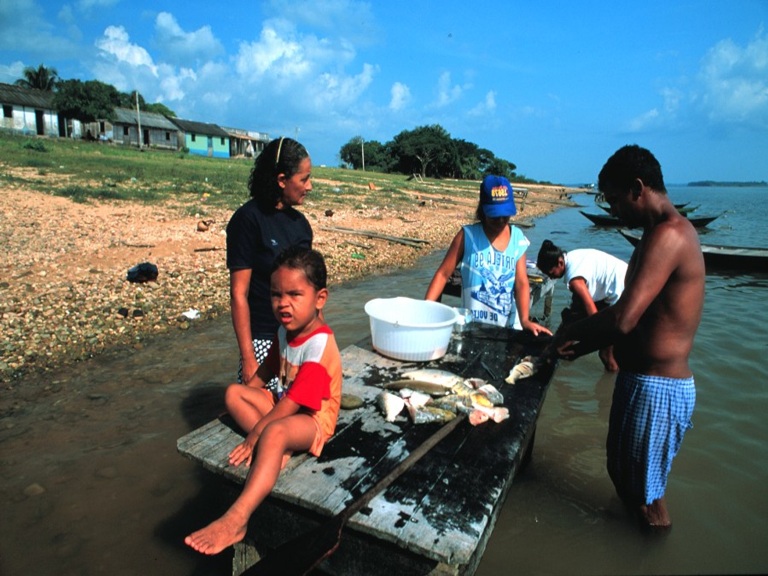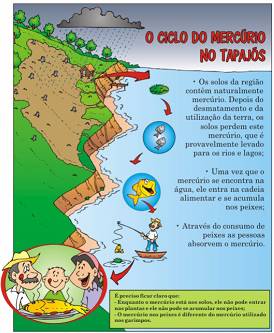Measuring Mercury Hair by Hair
Women Help Protect Against Mercury Contamination in Brazil’s Amazon
Mercury is one of the most poisonous natural substances on earth. It attacks the nervous system and brain. Small doses cause problems with coordination, vision and manual dexterity. More can be fatal. A group of women in Brazil did something to keep mercury out of their food chain. They grew their hair.
Along the way, they may also have uncovered a dietary secret to curbing the physiological effects of mercury contamination.
Kelly Haggart, Senior Writer at Canada's International Development Research Centre, explores how women are key participants in this unique research project.

In a small village beside a river in the heart of the Brazilian Amazon, 26 women keep a conscientious daily record of everything they eat for a year. They also let their hair grow. By the end of the year, they have produced detailed food diaries and long strands of hair for the Brazilian and Canadian scientists investigating high levels of toxic mercury in the region.
The women provide so much information through their enthusiastic record-keeping and hair-growing that it takes Brazilian doctoral student Carlos Passos six months to enter it all into a database. But when the results are analyzed, researchers are intrigued by a finding of potentially wide importance - fruit consumption has influenced mercury levels in the women's hair. Could fruit turn out to offer some protection from the mercury contaminating the fish that they eat?
"Hair grows at the rate of about a centimetre a month," says biologist Donna Mergler, emeritus professor at the Université du Québec à Montréal (UQAM). "So we cut the strands of hair into centimetres and examined the relationship between what the women had eaten and their mercury levels. And we found that those who ate more fruit had less mercury, for the same amount of fish."
Halfway through the year, Elizete Gaspar, a Brazilian graduate student working with Mergler on the food survey, asked the women if they had wearied of the effort. They insisted they enjoyed it, that gathering at 4 p.m. every day at the health clinic had become a pleasant social event. They ticked off items on a checklist and then wrote in details, such as which of the 40 local fish species they had eaten in the past 24 hours. The village midwife discussed their entries with them, and helped those who had difficulty writing complete the form.
"And the women told Elizete," Mergler recalls, "that ‘doing this also makes us realize the relationship between the food that we eat and our health. So no, no! We want to continue!'"
On the Mercury Trail
It was the connection between food, health, and the environment that first brought researchers to the village of Brasília Legal in the early 1990s. Scientists from UQAM teamed up with counterparts from the Universidade Federal do Pará to investigate the source of mercury contaminating the Tapajós River, a major tributary of the Amazon in northern Brazil.
Mercury in soil is usually harmless, because most plants can't absorb it, but it becomes hazardous once it enters aquatic systems. Fish take up some of this methylmercury, as this most toxic form of the element is called, through eating plankton. However, it is the carnivores, the fish who eat other fish, who are most contaminated as the mercury travels up the food chain.
"People are Sensible"
In studying the mercury content of the local fish, the researchers found that predatory species were much more contaminated than plant-eating varieties. The villagers were involved from the outset in seeking solutions. At a community workshop, a suitably positive slogan for a fish-dependent population was worked out: "Eat more fish that don't eat other fish."
Villagers also felt posters would help spread the message. Three white fish were displayed against a red, a yellow, and a green background to represent the descending order of hazard. The "red" category contained the predatory fish best eaten infrequently, while the "green" group included herbivores that could be consumed 10 times as often as carnivores.
"Fish don't have the amount of mercury stamped on their forehead, so this allowed a notion of quantity that was helpful," Mergler says.
The results were spectacular. In 1995, the researchers tested the mercury levels of 47 people and recorded their fish consumption for the previous week. When the same people were tested five years later, they were eating the same quantity of fish as before but their mercury levels had fallen by 40%.
"People are sensible," Mergler says. "It shows that when people are part of a research project, they can appreciate the findings."
Soon afterward, the 26 women who kept the year-long food diaries brought to light the potential importance of including fruit in the mix. More research on fruit and mercury needs to be done, and in other parts of the world as well, before a protective effect can be clearly established and declared universally valid.
The Invisible Power of Women
Women were key in communicating the crucial message about modifying fish consumption, both to their families and other villagers. For a start, they tended to be less skeptical than men about the threat posed by mercury.
The researchers also found that women act as intermediaries, allowing different groups to communicate with one another, especially about eating habits. Even in a small community, factors such as work and socio-economic status, location in the village, and religious affiliation had created distinct "discussion networks." More often than not, women were at the hub of the networks, and provided links to other groups.
Women also made most family food decisions and were at the centre of most social webs in the village. The researchers found that the real focal points in the village - the "opinion leaders" whose views carried the most weight on important matters pertaining to health and environmental degradation - were often women, rather than the official village chief or local priest one might have expected. In her PhD thesis, Elizete Gaspar calls this "the invisible power of women."
Excerpted and Reprinted from Women & Environments International Magazine Issue 76/77 Women and Toxins. Article © 2007 International Development Research Centre. All rights reserved. Reprinted with permission.


